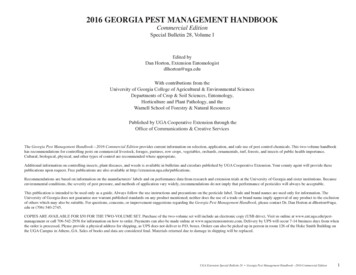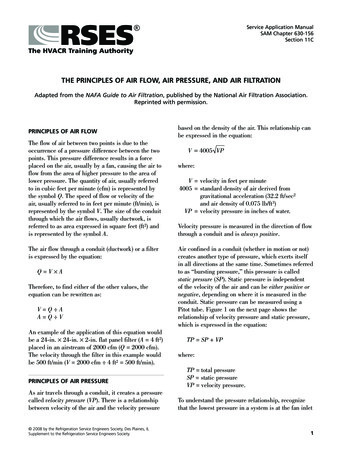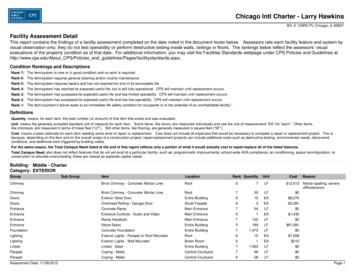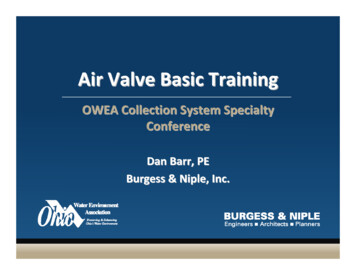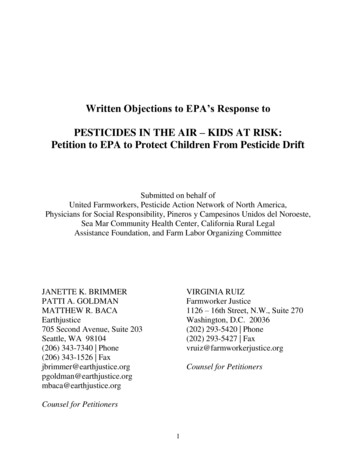
Transcription
Written Objections to EPA’s Response toPESTICIDES IN THE AIR – KIDS AT RISK:Petition to EPA to Protect Children From Pesticide DriftSubmitted on behalf ofUnited Farmworkers, Pesticide Action Network of North America,Physicians for Social Responsibility, Pineros y Campesinos Unidos del Noroeste,Sea Mar Community Health Center, California Rural LegalAssistance Foundation, and Farm Labor Organizing CommitteeJANETTE K. BRIMMERPATTI A. GOLDMANMATTHEW R. BACAEarthjustice705 Second Avenue, Suite 203Seattle, WA 98104(206) 343-7340 Phone(206) 343-1526 orgmbaca@earthjustice.orgVIRGINIA RUIZFarmworker Justice1126 – 16th Street, N.W., Suite 270Washington, D.C. 20036(202) 293-5420 Phone(202) 293-5427 Faxvruiz@farmworkerjustice.orgCounsel for PetitionersCounsel for Petitioners1
WRITTEN OBJECTIONS TO EPA’S MARCH 31, 2014 RESPONSE TO“PESTICIDES IN THE AIR—KIDS AT RISK: PETITION TO EPA TOPROTECT CHILDREN FROM PESTICIDE DRIFT (2009)”These objections are submitted on behalf of original petitioners Pesticide Action Networkof North America (“PANNA”), United Farmworkers, Pineros y Campesinos Unidos delNoroeste, Sea Mar Community Health Center, California Rural Legal Assistance Foundation,Physicians for Social Responsibility, and Farm Labor Organizing Committee (collectively“Petitioners”). These objections are submitted under 21 U.S.C. § 346a(g)(2)(A) and inaccordance with 40 C.F.R. §§ 178.20 and .25.SUMMARYPetitioners object to the U.S. Environmental Protection Agency’s (“EPA”) Response to“Pesticides in the Air—Kids at Risk: Petition to EPA to Protect Children from Pesticide Drift(2009)” (the “Kids Petition”)1 based upon the following:1.EPA’s Response leaves in effect the tolerances originally developed under theFQPA with its refusal to timely and quickly correct exposure assessments to includeconsideration of drift exposures when setting tolerances under the Food Quality Protection Act(“FQPA”) by 2006. EPA’s Response unreasonably and arbitrarily continues EPA’s ongoingviolation of the FQPA and leaves children unreasonably at risk for pesticide exposures;2.In deciding to leave the incomplete and inadequate tolerances in place with nointerim protections, EPA is in violation of its obligation under the FQPA to include an additionaltenfold safety factor to protect infants and children due to the incompleteness of data forpesticide drift and failure to assess all aggregate exposures for which it had reliable information1The Kids Petition is attached without original exhibits as Exhibit A; exhibits to the KidsPetition were submitted to EPA at the time of filing the Kids Petition. EPA’s Response to theKids Petition is attached as Exhibit B.2
in EPA’s initial setting of tolerances in 2006.Petitioners do not seek an evidentiary hearing as the questions presented are legal issuesonly.RELIEFPetitioners ask EPA to immediately correct its failure to consider pesticide drift in settingtolerances. Pending EPA’s reconsideration of tolerances to take into account pesticide drift(regardless of whether EPA moves immediately or on a longer timeframe), EPA must at aminimum immediately amend tolerances to include an additional tenfold safety factor to accountfor incompleteness of data, as provided for and required by the FQPA.FEE WAIVERUnder 40 C.F.R. § 180.33(i), objections to a tolerance must be accompanied by a filingfee of 4,050.00. The Administrator may waive or refund the filing fee when doing so willpromote the public interest. Id. § 180.33(l). Further, while the regulations provide that anadditional fee of 2,025.00 must accompany every request for a fee waiver, that additional fee isnot required when the objecting party has no financial interest in the outcome of the objection.Id. While Petitioners are providing the initial 4,050.00 fee with this Objection, Petitionersrequest the Administrator waive the fee requirement and refund the amount in full. None of thePetitioners has any financial interest in the tolerances at issue or any of the chemicals that maybe affected. Petitioners seek to protect the public from health risks associated with pesticidedrift. Many of the Petitioners represent and work with persons who have personally beenaffected by pesticide drift, either through exposure to themselves or members of their families.As noted in the Kids Petition, many of the communities affected by drift are rural communitieswith higher poverty rates, raising environmental justice issues. Imposition of this large fee is andwill be a significant barrier and deterrence to members of the public asserting their rights under3
the law by pursuing the objection process to protect their communities. By creating a highbarrier to pursuing justice for those directly affected by pesticide drift, such an onerous fee“would work an unreasonable hardship” on Petitioners, and “waiver or refund will promote thepublic interest.” See id. EPA should grant Petitioners’ request for fee waiver in this case.BACKGROUNDI.PESTICIDE SPRAY DRIFT IS A RECOGNIZED THREAT TO CHILDREN ANDFAMILIES THAT IS UNADDRESSED BY CURRENT REGULATORYPROTECTIONS.A number of epidemiological studies link pesticide drift to specific adverse health effectsin humans, including autism spectrum disorders,2 Parkinson’s disease,3 and childhood acutelymphoblastic leukemia.4 For decades, EPA has required pesticide labels to include generaladmonitions to avoid spray drift, but EPA has also repeatedly recognized that this generalizedlabel direction is inadequate to protect innocent bystanders, such as children, from drift. Forexample, the Worker Protection Standard (“WPS”) regulations have included a provisiongenerally requiring pesticide users to “assure that no pesticide is applied so as to contact, eitherdirectly or through drift, any worker or other person . . . .”5 With only this general labeldirection, EPA found that numerous poisoning incidents were occurring each year and the2E.g., Roberts, E., et al., Maternal Residence Near Agricultural Pesticide Applications andAutism Spectrum Disorders Among Children in the California Central Valley, Envtl. HealthPerspectives, Vol. 115, No. 10, at 1482 (Oct. 2007), attached to Kids Petition.3E.g., Costello, S., et al., Parkinson’s Disease and Residential Exposure to Maneb and ParaquatFrom Agricultural Applications in the Central Valley of California, Am. Journal ofEpidemiology, Vol. 169, No. 8, at 919 (Jan. 2009), attached to Kids Petition.4E.g., Rull, R., et al., Residential Proximity to Agricultural Pesticide Applications andChildhood Acute Lymphoblastic Leukemia, Envtl. Research, Vol. 109, at 891 (July 2009),attached to Kids Petition.540 C.F.R. § 170.210(a).4
current drift labeling was “inconsistent or inadequate and for many products unclear toapplicators and others.”6In order to provide better protections from drift, EPA initially took two actions. First, itestablished a “Spray Drift Task Force” (“Task Force”) charged with helping to develop “ageneric spray drift database which is expected to be capable of satisfying spray drift datarequirements for virtually all pesticide product registrations in the United States and Canada.”7The Task Force ultimately developed an evaluation tool—called “AgDRIFT”—that can helpestimate exposure from spray drift for individual pesticides.8 Second, EPA published a noticeproposing “improved and more consistent product label statements for controlling pesticide driftin order to be protective of human health and the environment.”9 EPA explained why it believednew spray drift label language was necessary:EPA’s position on pesticide drift is that applicators must not allow pesticide sprayor dust to drift from the application site and contact people, animals, and certainsensitive sites, including structures people occupy . . . , parks and recreation areas,nontarget crops, aquatic and wetland areas, woodlands, pastures, or rangelands.The Agency believes this is prudent public policy. It sets high but appropriatestandards for applicators to protect people and the environment. . . . EPA believesthe suggested labeling in this Notice will reduce risks associated with pesticidedrift without a significant reduction in product efficacy. Accordingly, EPAbelieves that these label statements will help ensure that the requirements ofFIFRA are met and, specifically, that pesticides are used in a manner that does notresult in “unreasonable adverse effects on the environment.”106EPA, Pesticide Registration (PR) Notice 2001-X Draft: Spray and Dust Drift Label Statementsfor Pesticide Products, attached to Kids Petition. See also continuing reported incidents inWashington State since 2001 and most recently, in spring of 2014, infra at 4-5.7EPA, Pesticide Registration (PR) Notice 90-3: Announcing the Formation of an Industry-WideSpray Drift Task Force (Apr. 6, 1990), attached to Kids Petition.8Task Force, AgDRIFT Frequency Asked Questions (July 31, 2003), attached to Kids Petition.9Draft Spray Drift PR Notice.10Id.5
EPA’s proposal would have placed limits on application equipment, methods, and conditions,such as wind speeds to reduce drift exposures.11 Unfortunately, EPA’s efforts stalled at thispoint with no change to pesticide labels or registrations.As set forth in the Kids Petition, poisoning incident reports continue to show thatpesticide drift poses significant risks to people. For example, in 2006, the Washington StatePesticide Incident Reporting and Tracking Review Panel found that “[e]xposure to pesticide driftis an important cause of documented pesticide-related illness in Washington.”12 The CaliforniaDepartment of Pesticide Regulation (“CDPR”) documented 3,997 reported pesticide driftincidents in California between 1992 and 2007.13 Moreover, it is well-documented that actualreported drift incidents are simply the tip of the iceberg in that many incidents go unreported dueto the well-documented disincentives and obstacles to such reporting.14Numerous other drift exposure events have occurred in Washington and elsewhere. InWashington State in 2012 and 2013, there were 72 pesticide drift incidents, 35 of which involveddirect human exposure.15 In one of these incidents, six children and two adults were drifted on11Id.12Washington State Pesticide Incident Reporting and Tracking Review Panel, Annual Report:2005, at 81 (May 2007), attached to Kids Petition.; see also Barbara Morrissey, WashingtonState Department of Health, Spray Drift and Human Health Incidents, attached to Kids Petition.13Cal. Dep’t of Pesticide Regulation, California Pesticide Illness Query, attached to KidsPetition.14See General Accounting Office, Pesticides: Improvements Needed to Ensure the Safety ofFarmworkers and Their Children (Mar. 2000), attached to Kids Petition. See also, EPA,Regulatory Impact Analysis of Worker Protection Standard for Agricultural Pesticides, at V-11 toV-20 (Aug. 1992), attached to Kids Petition.15Bud Hover, Director Washington State Department of Agriculture Pesticide ManagementDivision, 2013 Annual Report to the Legislature at 11 (Feb. 2014), available athttp://goo.gl/h5FFcz.6
by Oxamyl, Pyraclostrobin, and Metriam.16 In Washington, spray drift “continues to be the mostfrequent type of complaint involving pesticide applications.”17 In the spring of 2014,Washington is reporting record-high number of pesticide drift events sickening workers.18 It ishighly likely that pesticides harming workers are drifting to nearby areas and exposing otherinnocent bystanders as well. At a minimum, the ongoing problems with drift sickening—and attimes hospitalizing—workers and bystanders reinforces the inadequacy of generalized cautionarylabel language regarding drift.Petitioners have also provided EPA with ongoing evidence of drift exposures suffered byPetitioners’ own members. After EPA’s four-year silence on the Kids Petition, a number of thePetitioners filed a mandamus petition in the Ninth Circuit of the U.S. Circuit Court of Appeals in2013 in order to compel EPA to respond. With the mandamus filing, a number of declarationsfrom members of the petitioning organizations showed that drift incidents continue to exposefamilies and communities to pesticides drift, well after the 2009 filing of the Kids Petition. Forexample, Manuel Silveira submitted a declaration describing the ongoing exposure to pesticideshe, his family, and his community suffer through spray drift, including acute exposure tochloropicrin.19 Bonnie Wirtz, another declarant in the mandamus action, suffered a pesticidedrift event at her home in rural Minnesota.20 Ms. Wirtz’s infant son was also likely exposed16Id. at 12.17Id. at 10.18See, Washington Dep’t of Health Press Release, enclosed as Exhibit C. See also letter fromColumbia Legal Services describing earlier drift and chlorpyrifos incidents in Washington State,enclosed as Exhibit D.19Silveira Decl. ¶¶ 6-12, enclosed as Exhibit E.20Wirtz Decl. ¶¶ 4-8, enclosed as Exhibit F.7
through the drift incident.21 Howard Hurst, a teacher at a school in Hawaii, filed a declarationdescribing how teachers and students have been repeatedly exposed to drifting pesticides atschool from test fields adjacent to the school.22 In these incidents, children at the school andother teachers have been directly exposed to pesticides.23 Copies of the relevant declarations areincluded with these objections as Exhibits E through G. Finally, as part of comments critiquingEPA’s recently-proposed drift assessment guidance (EPA Docket No. EPA-HQ-OPP-20130676), Petitioners submitted additional evidence of drift incidents such as a reported incident inCalifornia where a school bus was directly drifted on with some kids reporting symptoms ofpesticide exposures.24 In that incident, a school bus full of children near Stockdale, Californiawas directly exposed to chlorpyrifos in an aerial application drift incident with some studentsexhibiting symptoms of exposure.25 Inspectors were able to confirm the presence of chlorpyrifosthrough swabs and clothing samples.26Pesticide drift is and continues to be a significant route of exposure for many childrenwho live or go to school near agricultural fields. In light of the heightened vulnerabilities ofchildren to pesticides, EPA cannot ensure that children will be protected from harm unless itaccounts fully for such exposures and, in cases of missing data, applies an additional tenfoldsafety factor. Each year that EPA delays addressing its failure to consider pesticide drift21Id.22Hurst Decl. ¶¶ 6-18, enclosed as Exhibit G (without attachments. See court file forattachments).23Id.24See incident reports, enclosed as Exhibit H.25Id.26Id.8
exposures in setting pesticide tolerances under the FQPA, more children and families areexposed to unsafe levels of risk.II.EPA FAILED TO INCLUDE PESTICIDE DRIFT EXPOSURES IN SETTINGTOLERANCES FOR PESTICIDES.In 1996, Congress unanimously adopted the FQPA, amending the Federal Food, Drugand Cosmetic Act (“FFDCA”) to incorporate the National Academy of Science’s 1993recommendations for EPA to ensure that children are protected from pesticide exposures.27Under the FQPA, before EPA can allow a pesticide residue on a food, the agency must “ensurethat there is a reasonable certainty that no harm will result to infants and children from aggregateexposure” to the pesticide.28 The FQPA defines “aggregate exposure” to include “all anticipateddietary exposures and all other exposures for which there is reliable information.”29 The FQPAgave EPA 10 years—until 2006—to bring all uses of pesticides on food into compliance with thenew standards.To implement these statutory mandates, EPA has developed a “risk cup” approach thatfirst quantifies the exposure level for a pesticide that would exceed the safety standard forspecific population groups, including fetuses, infants, and children in different age ranges. EPAthen adds up exposures from various sources, such as consumption of each food on which thepesticide is used, residues in drinking water, and exposure to the pesticide through residentialuses. If aggregate exposures to the pesticide from non-occupational sources “overflow” the riskcup for a particular subpopulation, the pesticide does not meet the FQPA safety standard. EPA27H.R. Rep. No. 104-669, Pt. 2, at 43.2821 U.S.C. §§ 346a(b)(2)(C)(ii)(I), (II).2921 U.S.C. § 346a(b)(2)(A)(ii) (emphasis added); see also 21 U.S.C. § 346a(b)(2)(C)(vi) (Insetting tolerances, EPA “shall consider . . . available information concerning the aggregateexposure levels of consumers . . . to the pesticide chemical and to other related substances,including dietary exposure . . . and exposure from other non-occupational sources . . . .”).9
will then look for ways to reduce exposure by, for example, eliminating some uses to reduce totalexposure to levels that meet the safety standard.The FQPA also amended FIFRA’s “unreasonable adverse effects” definition to include“a human dietary risk from residues that result from a use of a pesticide in or on any foodinconsistent with the [FQPA] standard.”30 Accordingly, EPA can register a pesticide only ifthere is reasonable certainty of no harm from aggregate exposure to the pesticide under theFQPA standard.31 EPA can impose use restrictions as necessary to meet this standard, which areincluded on the legally enforceable pesticide label. Early on in its implementation of theFQPA’s aggregate exposure mandate, EPA acknowledged that non-food exposures to childrenhad to be assessed and could lead to use restriction and tolerance revocation. For example, in2000 and 2001, EPA negotiated a phase-out of almost all home and garden uses of theorganophosphates chlorpyrifos and diazinon after determining that residential uses of thesepesticides cause the child risk cup for each of these pesticides to overflow.32 The August 2006deadline for bringing food-use pesticides into compliance with the FQPA extends to bothtolerances under the FFDCA and registrations under FIFRA.33307 U.S.C. § 136(bb)(2).31E.g., EPA, General Principles for Performing Aggregate Exposure and Risk Assessments, at 9(Nov. 28, 2001), Attachment 28 (“[T]he [FIFRA] standard for making decisions whether toregister or continue registration of a pesticide for food-use must satisfy the standards in theFFDCA.”).32EPA, Occupational/Residential Handler and Postapplication Residential Risk Assessment forChlorpyrifos, at 6 (Oct. 1999), attached to the Kids Petition 26; EPA, Diazinon Revised RiskAssessment and Agreement with Registrants, at 2-3 (Jan. 2001), attached to the Kids Petition.33Use restrictions are set out on the EPA-approved label affixed to the product. A pesticide maynot be used in a manner inconsistent with the label. If EPA determines that a pesticideregistration does not comply with FIFRA, it may commence administrative proceedings tocancel the pesticide’s registration or amend the registration to require additional safeguards.7 U.S.C. § 136d(b).10
As EPA has admitted,34 it failed to consider and include pesticide drift exposures whencompiling and analyzing children’s exposures in its risk cup analysis for its initial setting oftolerances under the FQPA directive by 2006.35 It is only after the filing of the Kids Petition thatEPA has done some assessment of spray drift of chlorpyrifos and set interim (very small) spraybuffers pending completion of the registration review.36 EPA agrees that it is required toconsider drift as it has acknowledged repeatedly for years,37 but EPA disagrees that it mustcorrect its earlier failure to do so in a timely fashion despite its original 2006 deadline.38 EPAhas in effect admitted a major gap in its data and health protections, but it has made no effort toprovide full protection to children by expediting corrected analysis, or by taking interimprotective steps. Acknowledging risk does not, on its own, reduce risk.III.EPA’S RESPONSE TO THE KIDS PETITION DENIES A TIMELY CORRECTIONTO ITS ACKNOWLEDGED FAILURE TO ADDRESS DRIFT IN SETTINGTOLERANCES AND DENIES NECESSARY INTERIM PROTECTIVE MEASURESWHILE IT COMPLETES ITS LENGTHY PROCESS TO CORRECT THIS LEGALERROR.Petitioners filed the Kids Petition in October of 2009. EPA sought public comment onthe Kids Petition, extending the comment period to March 5, 2010. EPA gave no other response34Prior to filing the Kids Petition, EPA’s reregistrations of pesticides were challenged inlawsuits that raised exactly this issue. See, e.g., United Farm Workers v. Adm’r, Envtl. Prot.Agency, 592 F.3d 1080 (9th Cir. 2010). That case was ultimately dismissed for lack ofjurisdiction, precipitating the filing of a petition challenging chlorpyrifos tolerances under theFQPA and leading Petitioners to request the modification of tolerances in the Kids Petition.35See EPA Response at 32-33.36Id. at 33. EPA also has recently done some assessment of volatilization risk of chlorpyrifosand some other fumigant pesticides. Petitioners concern themselves here primarily with spraydrift and in either case, none of this recent assessment occurred in compliance with EPA’s initialFQPA obligations nor has it led to completion of work on whether revised or revoked tolerancesmay be necessary when taking into account drift exposures.37See EPA Response at 32-34.38Id. at 34-36.11
on the Kids Petition until, having received no response, a subset of Petitioners filed suit tocompel a response in the summer of 2013. Petitioners initiated the lawsuit almost four yearsafter filing the Kids Petition and seven years after EPA was required to complete considerationof all exposures to pesticides, including drift (as EPA now admits), and to set tolerances in itsFQPA processes. EPA finally responded to the Kids Petition on March 31, 2014 (“EPAResponse”). EPA effectively denied the relief requested promising only to comply with the lawin the future by considering only some avenues of exposure to pesticide spray drift as it movedthrough its lengthy registration review process.The Kids Petition sought two basic forms of relief. First, it sought immediate compliancewith the FQPA obligation to set tolerances that are protective based upon children’s aggregateexposures to pesticides, including drift. Recognizing that EPA’s registration review process wason an extremely lengthy timeline (completion in 2022), Petitioners asked that EPA act morequickly to correct the acknowledged failure to include drift than the extended registration reviewprocess timeline.39Second, the Kids Petition sought interim protections for children from exposures topesticide spray drift while EPA’s process of correcting its earlier failure was pending (regardlessof whether EPA moved quickly, or, especially if EPA refused to move more quickly than itsregistration review process). The Kids Petition offered spray application buffers as a strongalternative for interim protections, particularly for those pesticides such as organophosphates and39While EPA has voluntarily set earlier deadlines for some pesticides, EPA’s history of pesticidereregistration and/or reconsideration of tolerances is dismal in terms of timeliness, with EPArarely conforming to promised deadlines, even when those promises are made to, and relied uponby, U.S. Circuit Courts. See, Order, In re: Pesticide Action Network of N. Am. and Natural Res.Def. Council, Court File No. 12-71125 (9th Cir. July 10, 2013) (finding that EPA “set forth aconcrete timeline for final agency action that would resolve the Petition by February 2014”).EPA has not met the February 2014 deadline and has refused to commit to an enforceable newdeadline.12
carbamates where EPA’s earlier risk cup analysis left little room for error. During the commentperiod on the Kids Petition, PANNA even offered calculated buffers for EPA’s ease ofapplication.40 While other alternatives for interim protection exist and could also have served thepurpose (e.g. control of spray drift through technical methods such as droplet size and spraynozzle adjustment, also based upon work of the Task Force, or through other protection measuressuch as additional safety factors—see EPA Response at 27), buffers are simply-applied andproven-effective.EPA has rejected both requests. EPA purports to “accept” the Kids Petition bycommitting to include drift exposures as part of its plodding and never-ending registrationreview process, but EPA’s commitment is nothing more than what it has always been legallyrequired to do. Essentially, EPA is “committing” to obey the law at some time in the futurewhen it gets around to correcting its earlier mistakes—that originally should have been correctedby 2006—and, in the meantime, exposure to pesticide drift continues to be unaccounted for inEPA risk analysis.41 EPA otherwise completely denies the Kids Petition, leaving in place theinadequate and/or incomplete tolerances initially set under FQPA with no consideration of driftas part of the required risk assessment and obligation to protect infants and children.40Letter from Karl Tupper, PANNA, dated March 5, 2010, EPA Docket EPA-HQ-OPP-0825(and 0628).41EPA has also stated its intent not to consider direct exposure to pesticide spray drift in itsrecent draft guidance, Residential Exposure Assessment Standard Operating Procedures (SOPs),Addenda 1: Consideration of Spray Drift (“Spray Drift Assessment Guidance”), EPA Docket No.EPA-HQ-OPP-2-13-0676. Petitioners commented on the Spray Drift Assessment Guidance andpointed out that in omitting a known avenue of exposure, direct exposure to pesticides, EPA willbe acting contrary to the obligation under FQPA for EPA to consider all avenues of exposure topesticides. PANNA et al. Comments on Spray Drift Assessment Guidance at 3-6. Agencies maynot assume compliance with the law when evaluating proposed courses of action whereviolations are known to occur regularly. See, e.g., Found. for N. Am. Wild Sheep v. U.S. Dep’t ofAgric., 681 F.2d 1172, 1178-79 (9th Cir. 1982).13
EPA denies that it has any obligation to modify tolerances now or that the recordsupports moving more quickly than its standard registration review process (the only deadline forwhich is 2022—a full 16 years after the FQPA deadline and 13 years after the date of the KidsPetition—almost a generation of kids later). EPA has decided that its process is whollyimmutable regardless of admitted errors and its mandate to protect children.42Moreover, EPA denies any need for or obligation to impose interim protections. Again,EPA appears to take the position that it must plod through its registration review process tocompletion before it can take any steps to protect kids from pesticide drift, despite ampleevidence that children continue to be exposed to pesticide drift and despite its earlier, admittedfailure to comply with its obligations to complete tolerances by 2006 that take into account allexposures, including drift, when setting tolerances. EPA Response at 2-3, 13, 32-35. EPA’sinsistence on leaving inadequate tolerances in place with no additional safety factor or interimprotections while simultaneously insisting on a long, slow process that will years-hence includeconsideration of children’s drift exposures is unsupported by the law or the record.OBJECTIONThese objections challenge EPA’s refusal to quickly and timely act to correct its failure toinclude pesticide drift in its risk assessments for setting FQPA tolerances for pesticides by 2006and to impose required additional tenfold safety factors during the period of time that EPA’sreassessment of tolerances including drift is pending during its registration review process.42In fact, EPA’s response to the Kids Petition includes a curious statement about its perceivedmandate. EPA claims its “mandate” is to unflaggingly apply a lengthy process, EPA Responseat 3, but in fact, EPA’s mandate under the FQPA is to proactively protect infants and childrenfrom the negative health impacts of pesticides.14
I.EPA MUST IMMEDIATELY MODIFY TOLERANCES TO INCLUDE AT MINIMUMA TENFOLD SAFETY FACTOR TO ACCOUNT FOR ITS FAILURE TO INCLUDEPESTICIDE DRIFT.Under the FQPA, EPA was required to set tolerances for pesticides that were protectiveof infants and children, taking into account total aggregate exposures to all pesticides, includingdrift. 21 U.S.C. § 346a(b)(2)(C)(ii)(I), (II). EPA was required to complete those tolerances nolater than 2006. Id.at 346a(q). EPA admits that it failed in this obligation because it did not takedrift into account in setting those initial FQPA tolerances. EPA Response at 20-3, 6, 32-33.EPA has not completed any tolerance assessments in its registration review process, orotherwise, that include analysis of drift exposures and necessary reductions or mitigation to meetFQPA’s safety standard.EPA’s response that it will eventually follow the law, on an extended and apparentlyinalterable pesticide-by-pesticide schedule, is inadequate given that it has already missed the2006 FQPA deadline to set protective tolerances, it admits that was an error, and the recordmakes clear that children are being exposed to pesticide drift on a regular basis. EPA has anobligation to follow the law and correct its mistake quickly on an accelerated schedule thatreflects the risk posed to children by pesticide drift.More importantly, regardless of whether EPA acts to correct its mistake now, in the nearfuture, or over an extended period, for the period of time during which EPA is reassessingtolerances, it must immediately impose modified tolerances that are required under FQPA. TheFQPA requires EPA to apply an additional tenfold margin of safety for pesticide chemicalresidue and other sources of exposure when necessary to account for incompleteness of data withrespect to exposure and toxicity. 21 U.S.C. § 346a(b)(2)(C). See also Natural Res. Def. Councilv. U.S. Envt’l Prot. Agency, 658 F.2d 200, 216-17 (9th Cir. 2008). Indeed, the FQPA states thatEPA “shall” apply the additional tenfold margin of safety, which may be
The Task Force ultimately developed an evaluation tool—called "AgDRIFT"—that can help estimate exposure from spray drift for individual pesticides.8 Second, EPA published a notice proposing "improved and more consistent product label statements for controlling pesticide drift


